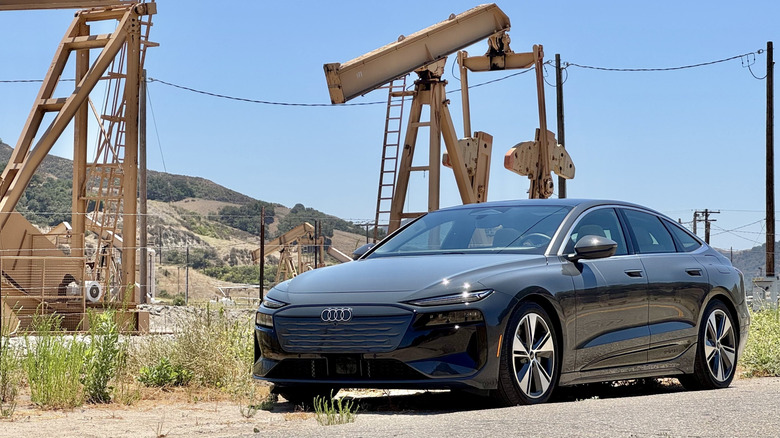
The U.S. electric vehicle market is in a precarious position thanks to President Trump's outspoken hatred of EVs and renewable energy, as well as his self-serving spending bill that will end all federal EV tax credits by September 30. Beyond cutting the EV tax credit, Trump's legion of Republican sheeple in the Senate and other government agencies have continuously rolled back environmental protections, Corporate Average Fuel Economy (CAFE) penalties, and green energy investments; none of which bodes
well for the future of EVs in America.
Mercedes-Benz just announced that it will pause production of U.S.-spec versions of its EQE and EQS models due to lack of demand, but Audi is convinced its new EVs will succeed. I drove Audi's nice Q6 and SQ6 E-Tron electric SUVs late last year, and now I've had the chance to sample the first vehicles that use what Audi calls the "low floor" version of the PPE platform, the A6 and S6 Sportback E-Tron. That low floor brings a host of benefits when compared to the "high floor" versions of the platform in the Q6 and SQ6 (and the Porsche Macan EV), but will they be enough to convince American consumers to go electric even without tax incentives? Audi hopes so, and so do I.

Full Disclosure: Audi invited me to participate in the first-drive program for the U.S.-spec A6 and S6 Sportback E-Tron, put me up in a beautiful oceanfront resort in Montecito, California and fed me gourmet food and drinks for a few days. None of which changes my impressions of the car, though I greatly appreciate it.
Read more: These Are What You Wanted As First Cars (And What You Got Instead)
The Numbers
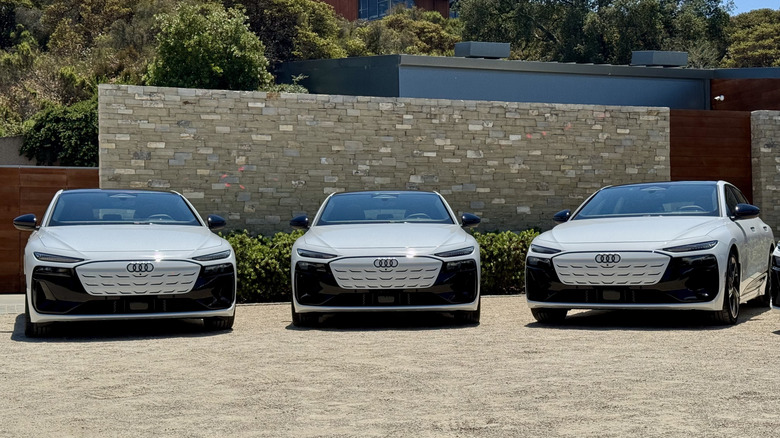
My colleague Andy attended the global first drive of the A6 and S6 Sportback E-Tron late last year and wrote a great review of the Euro-spec model, but the U.S.-spec model has a few tweaks, plus now we have finalized specs. In the U.S., the base rear-wheel-drive A6 Sportback E-Tron starts at $67,195 including $1,295 destination. Opting for the dual-motor A6 Sportback E-Tron Quattro bumps that up to $69,195, and the S6 Sportback E-Tron starts at $79,995.
All A6 and S6 E-Trons have a 100-kWh battery pack, 94.4 kWh of which is usable, and are built on an 800-volt architecture. They can charge at a maximum of 270 kW, which allows for a competitive 21-minute 10-to-80% charge time. Naturally, the single-motor A6 E-Tron has the longest EPA-estimated max range at an impressive 392 miles, and it's driven by a rear-mounted motor that produces 375 horsepower and 428 lb-ft of torque. Upgrading to the A6 Sportback E-Tron Quattro adds a front motor into the mix, bumping power up to 456 horsepower, but its maximum range drops a bit to 377 miles. The dual-motor S6 is the top performer of the group with 543 horsepower, but also the lowest maximum range of 324 miles.
The A6 E-Tron Quattro Is More Than Enough
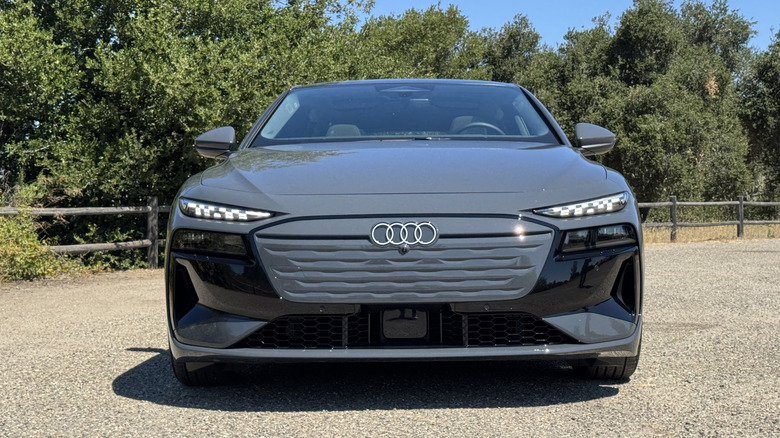
Audi only provided A6 E-Tron Quattros and S6 E-Trons for us to sample on this trip, so I cannot speak to the driving experience of the standard A6 E-Tron. I started my day in the A6 Quattro, which I found to be a wonderful all-arounder. Naturally Audi supplied us with top-spec Prestige trim cars, which come with Audi's comfort-tuned air suspension as standard. The air suspension paired with the standard acoustic front side windows combined to produce a remarkably isolated and comfortable driving experience. If luxury is your priority, the A6 Prestige is the trim to choose; in the default Balanced drive mode the suspension effortlessly soaked up small imperfections, and in Comfort mode it completely erased them. Audi put a lot of time and effort into molding the car's shape to minimize both drag and wind noise, and its efforts paid off in full – the A6 felt like an airy sensory isolation chamber even at highway speeds.
When the roads got twisty, the A6 didn't fall to pieces, either. In fact, it clung to the road like a limpet, obediently following the orders that my arms dictated through the steering wheel as long as I didn't come into a turn too hot. As with most cars of this size and weight — the dual-motor A6 E-Tron weighs 5,192 pounds — you can only enter a corner so fast before the front end starts to push wide. This isn't a demerit to the A6, in fact I was very impressed with its dynamic abilities, but it just doesn't goad you on or feel particularly playful when the turns get tight.
The S6 Is Incrementally Better
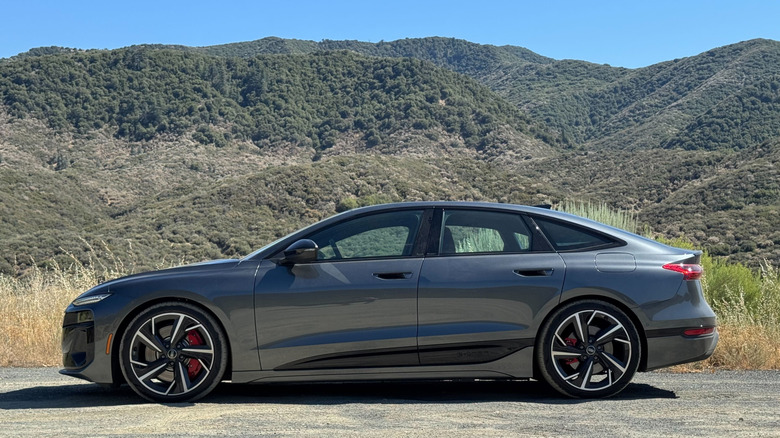
Considering the $13,390 price delta between the A6 E-Tron Quattro and the S6 E-Tron, the benefits of opting for that S badge are pretty minimal from my quick drive. The S6 is the only way to get Audi's lovely if not very tightly bolstered sports seats, red upholstery, 21-inch wheels, and OLED taillights with programmable light signatures, if any of those things are dealbreakers for you.
Its standard sport-tuned air suspension sits about an inch lower than the A6's optional comfort-tuned air suspension, and it did feel notably firmer than the A6. The Balanced drive mode in the S6 felt like Dynamic mode in the A6, so it's never harsh, but it did make road imperfections a bit more apparent. In the corners, the S6 felt like it had the same levels of grip as the A6 despite being fitted with the optional 21-inch wheels and summer tires versus the A6's optional 20-inch wheels on all-season run-flats, though its thicker sway bars did keep the car a bit flatter while taming the twists and turns in the Central Coast's winding mountain roads.

The 87-horsepower increase over the A6 was less apparent than I hoped it would be while on the move, but the S6's maximum output of 543 horsepower is only available when launch control is engaged; the rest of the time it makes do with 496 hp. The A6 Quattro achieves a 0-to-60 time of 4.3 seconds while the S6 drops that time down to 3.7 seconds; the S6 still felt quick, but not remarkably more so than the A6 Quattro in the real world.
You do get bigger brakes than the A6 in the S6, but the tech wizards at Audi managed to program both cars to use regenerative braking for the vast majority of stopping duties, so the difference wasn't particularly apparent. Regen even works in full panic-stop situations when the ABS is engaged, so I found that both cars had a similarly positive brake pedal feel and stopping power. When the regenerative braking let the calipers do some squeezing it was imperceptible to my foot, but there is a display readout that gives live feedback to show which systems are in use.
Touchscreens And Technology Galore
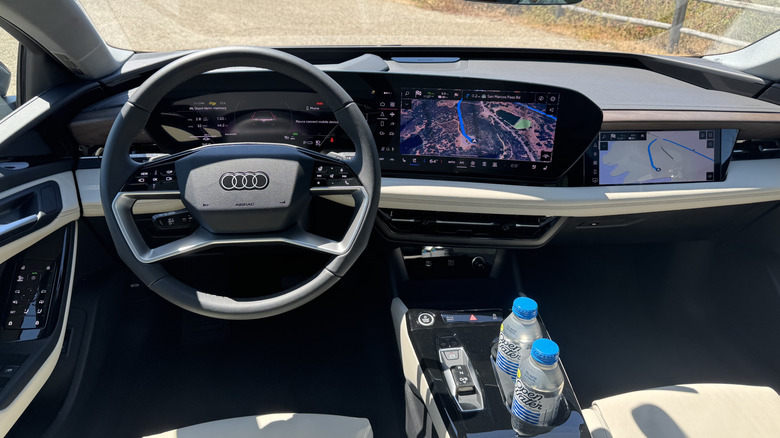
I fear that to many EV buyers, the importance of the technology onboard supercedes the importance of the driving experience. Luckily, the Audi A6 and S6 E-Trons offer excellence on both fronts, so long as you don't mind screen maxxing. As standard, all A6s come with Audi's latest OLED MMI system that includes an 11.9-inch virtual cockpit instrument display and a 14.5-inch infotainment touchscreen with wireless Apple CarPlay and Android Auto. Upgrading to Prestige trim brings a third screen into play, a 10.9-inch passenger screen, which is actually pretty cool but totally unnecessary.
Audi's digital ecosystem is all-consuming, so every task including altering your climate control settings is done through the touchscreen. That can be distracting, but using the voice assistant minimizes menu diving when it works properly. There are more complicated systems on the market, but there is still no substitute for physical buttons and knobs.
Beyond The Screens
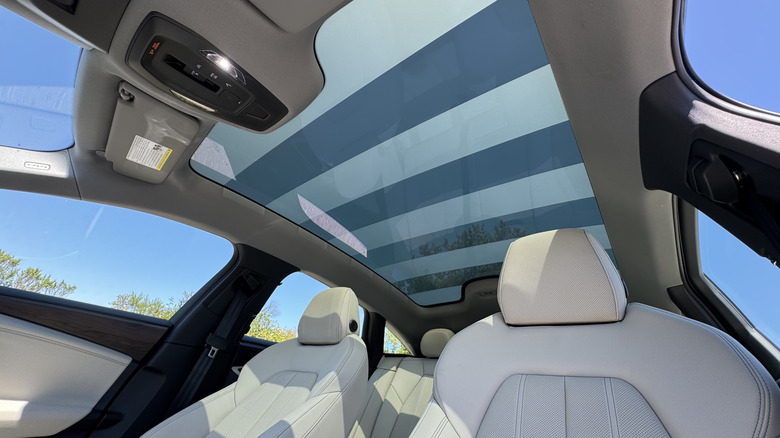
Every A6 comes standard with a fixed glass roof that has a very intuitive ceiling-mounted toggle to switch between varying levels of opacity, which sounds gimmicky, but in practice I quite enjoyed it. I found its frosted state to block light well and heat even better, and I love that you can choose to have only the rear half frosted to mimic a traditional sunroof.
The augmented reality head-up display that is standard on all trims above the base Premium model can be helpful at taking the guesswork out of misleading junctions, but it takes up a lot of the driver's view of the road. The steep rake of the windshield means the view out is already somewhat pinched, and the HUD worsens that; thankfully it can be switched off if you find it too distracting.

Like the Q6, the A6 gets an optional and totally bumpin' Bang & Olufsen sound system with speakers in the headrest to deliver in-ear navigation directions and phone calls. I found it to be alarming at first, but it quickly became a favorite feature. The A6 can also be had with selectable front LED daytime running light signatures, but the selectable OLED tail light signatures only come on the S6, and again, they're gimmicky.
All of the cars I drove were fitted with Audi's adaptive cruise assist which includes speed limit adoption, speed changes for curves, and adjustable driving styles and comes on all trims above the Premium (it has normal adaptive cruise control without those features). It did a brilliant job of navigating even twisty roads, and it only required my intervention a few times on very tight curves. The system contributed to the car's very relaxing and tranquil driving experience, especially on long stretches of highway.
Roomy And Versatile Interior
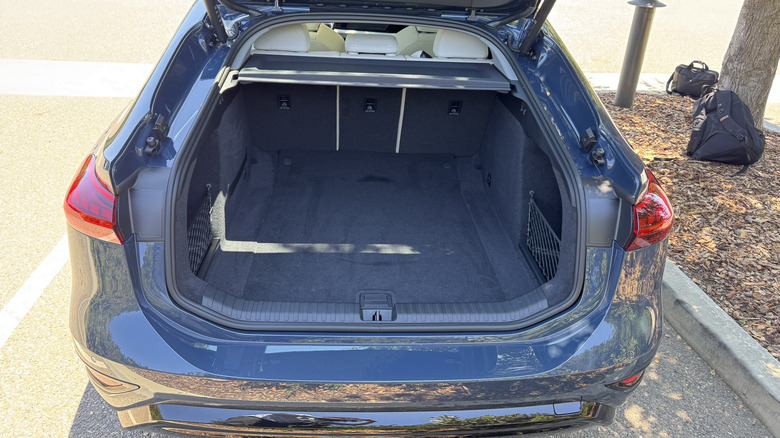
I found the A6's interior to be roomy and versatile, though the driver's seat did not go low enough for me to find an ideal driving position at my admittedly exceptional height at 6-foot-8. Weirdly, I found that the passenger seat felt much lower than the driver's seat despite Audi representatives saying there shouldn't be a difference. The too-high driver's seat position combined with the steeply raked windshield to make my view out the front feel very narrow, and I found that the rearview mirror fell directly in my line of sight. The rearview mirror position forced me to duck down in order to see around right turns, which became increasingly annoying on twisty mountain roads, though there was still plenty of headroom. At least the A6's fastback aerodynamic roofline doesn't compromise rear-seat headroom as much as it does in something like a Tesla Model 3 or Mercedes-Benz EQE, so the rear seat felt nicely spacious for a car in this size category.
Every A6 E-Tron is a Sportback instead of a traditional sedan, Audi's nomenclature for liftbacks like the A7 and A5. That hatchback made the 25.95 cubic-feet of trunk space large and versatile, and even moreso with the 39.87 cubic-feet of space with the rear seats folded down. That's significantly more than the Mercedes-Benz EQE, which has just 10.9 cubic-feet of space in its trunk. The platform also allows for a small frunk that should fit charging cables and adaptors quite nicely; the A6 doesn't have a NACS charge port yet, so buyers will have to make do with CCS and J1772 chargers for now. I asked Audi about when the platform would get an NACS charge port and they simply said "stay tuned," so don't hold your breath; Audi did say that NACS adaptors should be available soon, but no formal timeline was provided. That said, the A6 has charge ports on both the driver's side and the passenger side, though only the one on the driver's side is capable of fast charging.
Overall, I found the A6 and S6 Sportback E-Tron to be very agreeable EVs. They might not look particularly exciting, or be particularly exciting, but they are quick, fast-charging, efficient and comfortable. I struggle to see a world where they become sales successes for Audi in the U.S., but if you're one of the few people in America who wants a pricey electric sedan, the A6 and S6 Sportback E-Tron should be on your list.
Want more like this? Join the Jalopnik newsletter to get the latest auto news sent straight to your inbox...
Read the original article on Jalopnik.










